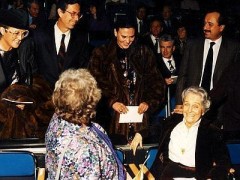
From research to the kitchen. From the laboratories of virology to the stovetops. Eliana Catalani left an international career, after 37 years along side the Nobel Prize winner Rita Levi Montalcini, to pursue her vocation as a refined and sophisticated gourmet chef.
At the helm of the restaurant Spirito Di Vino, on via Dei Genovesi, in the heart of ”old” Trastevere, Eliana Catalani began with a passion inherited from her father. She is joined by her husband Romeo (who artfully describes the menu) and her son Francesco, who oversees the cellar that houses over 800 wines. "Cuisine has much in common with my work as a researcher and lab technician," she explains. "When I plan an experiment I need to know which tools, components, materials are available to me."
”The laboratory organization is similar to the preparation of my dishes, made with what I define as an almost scientific criteria. The reproducibility, repeatability, standardization of the products is of utmost importance. Each product, in fact, must be observed, studied, as if in front of a microscope. There has to be in every dish," adds Eliana Catalani, "a logical structure, especially when making sweets and desserts. The recipes should always be the same, including flavors, even though we don’t exclude variables."
"The objectives in the kitchen are immediate however, unlike in the scientific universe. Immediacy is rare in science and research," explains Eliana Catalani. "A challenge that protracts itself in time, unlike in hospitality, is often subject to the opinions of experts, the publication of charts, and to detailed studies."
She began in the pediatric clinic at Policlinico Umberto I in collaboration with Rita Levi Montalcini, whom Eliana Catalani accompanied to Stockholm in 1986 to receive the Nobel Prize for Medicine. And Eliana remembers Montalcini as a great cook. "Her specialty? Chocolate sweets and coffee and zabaglione ice cream. And then I remember that she enjoyed very much organizing snack time for our children. Unforgettable afternoons."
"But – let's not forget– us assistants and collaborators also cooked for Professor Montalcini. Christmas was a fixed appointment for one of my cult dishes. I prepared a Crock pot roast, of course in a clay pot made by a craftsman from Petralli, in an ancient Etruscan oven dug into the tufa rock. Prosciutto, bacon, beef seasoned with celery, onions, thyme, bay leaves, salt and pepper and left to cook for 6 hours on two different days. It was a must during Christmas at the home of Professor Montalcini," the Roman chef explains, "next to the pork shin and the Calabrian cod prepared by two colleagues."
The same passion, the same self-sacrifice, even after many years, drives Eliana Catalani in the restaurant business. The cult dishes of Spirito Di Vino include: chickpea crepes with codfish sauce; veal meatballs with ginger; clafoutis of artichokes; and basil-scented ratatouille. Also, the lean pork “Mazio” style - an ancient recipe from the Rome of the Caesars; liver pate tied to traditions of Jewish descent; and a spaghetti with minced caper sauce from the island Li Galli. The chef of the restaurant in Trastevere wanted to dedicate this dish to John the young fisherman, who lived with the Massine family, who was one of the best choreographers and dancers of the 1900s and star of the Ballets Russes of Diaghilev, and to the little island which later was bought by Rudolf Nureyev.
"I do not deny that I love experimenting with food," says Eliana Catalani, "but above all, I want to make the kitchen, each recipe, each dish live as if it were a story. Instead of words, the scents, smells and tastes do the storytelling. Of course, all my dishes change with the seasons with some preferences," she adds. "I love black cabbage (kale). In soups, pies, with bread, leeks and radishes. A typical excellent autumn dish is mushrooms, possibly those of Lake Bracciano or Bolsena, or of Monti Cimini, with legumes of all kinds and varieties."